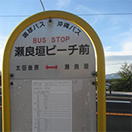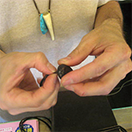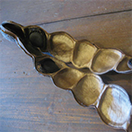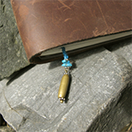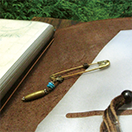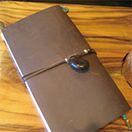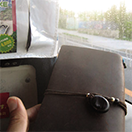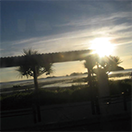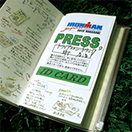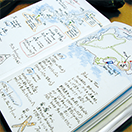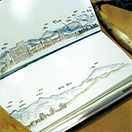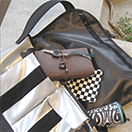Takahiro Sha / 謝 孝浩(作家・トライアスリート)
ローカルバスに乗った。
平日の昼下がり。乗っているのは、オジイやオバア。乗り降りするのにも、時間がかかる。時刻表より、少しずつ遅れていくけれど、誰もが、そんなことは気にする様子もないし、必要もない。おんぼろバスの中は、時間がゆっくり流れていく。
2時間かけて辿り着いたバス停は、海沿いの高台にあった。亜熱帯の強烈な日差しに中で、コバルトブルーの海の向こうに、島影が、遥か遠くに見晴らせた。このバスの小さな旅に駆り立てられたのは、この土地に、半年ほど前に移り住んだアーティストに会うためだ。自然素材をモチーフに作品を作り続けている。
最近、自分の旅の相棒でもあるお気に入りのトラベラーズノートを、彼に飾ってもらった。柔らかくも丈夫な鹿の皮紐で、ノートを巻く。紐をとめるのは、その土地で拾ったイルカンダという植物の豆。栞がわりの海と同じ色の麻紐には、アリゾナのトルコ石と真鍮のライスビーズをつけてくれた。彼の作品の中からは、心地よい風が吹き、土が香ってくる。
ほんの2時間ほどの滞在。僕はまたローカルバスに乗り込んだ。
車窓からは、いつの間にか、夕陽の柔らかい日差しが注ぎ込んでいた。
ひとりで旅をするときにはよくノートをつけます。
行き先に辺境が多いせいか、雑踏の屋台とかで、ひとり食事をしていると、結構淋しいんですよ。そんなときに、街角を見ながら、時間つぶしに書いたりします。
また、ひとり旅のときこそ、今思っていることを素直に書き留めたりしますね。
ご飯を食べているときや歩いているときに、見たもの、感じたものを記録に残したいという気持ちが湧き上がっても、少し時間が経つとすぐに忘れてしまう。
だから、そのときすぐに書き留める。少しだけでも良いんです。そのとき頭をよぎった言葉や感じたことは、写真には残らない。だから書くことは重要だと思います。
今回の沖縄もひとり旅。半日自由な時間が取れたので、トラベラーズノートを飾るためのパーツを探しに知り合いのアーティストの店を訪ねました。そんなフットワークの軽い動きが出来るのもひとり旅の魅力です。
“A Notebook that Invites One to a Journey”
I rode on a bus.
It was a weekday afternoon. The bus was filled with old men and women, and it takes time for people to get on and off the bus. The bus gradually gets delayed from schedule, but nobody seems to care. In the first place, is there any reason to worry about it? The time seems to be flowing slowly inside this old bus.
The bus stop that I arrived after a two hour ride was located on a hill facing an ocean. Under a strong, flashing sunlight, a shadow of an island can be seen beyond the cobalt blue colored ocean. The artist who lives in this area motivated me to go on a mini journey that involves a bus. The artist makes works by using natural materials as its motif and has moved here half a year ago.
I asked him to decorate my TRAVELER’S notebook, which has turned into my traveling partner. The notebook is wrapped using a rope made of soft and firm deer leather. The rope is bounded using a bean called “Ilkanda,” which was picked from the location the artist lives. As a bookmark, a string made of hemp that has a same color as the ocean was attached. The string was decorated with turquoise and a rice bead made of brass. Through his artwork, I can sense a pleasant breeze flowing in and smell the land.
It was just a two hour stay. I rode on the same bus again.
From the window, I can see a sunset pouring a soft and warm light.
Whenever I travel alone, I take notes frequently.
I tend to travel to remote regions, and whenever I eat at local food stands alone, I always feel lonely. To distract this feeling, I just write.
One thing I realize when traveling alone is that in a situation like this, it makes people take notes in a truthful manner.
When we eat or walk around, things that come up to our mind and motivates us to take notes tend to fade away as time proceeds.
That’s why I write at that moment. Just a little would do. The things that flashes through our minds will not be recorded in a photo. That’s why writing is important.
This time, I went to Okinawa by myself. I was able to make myself a spare time for half a day so I visited an artist who I know to see if I can find any parts to decorate my TRAVELER’S notebook. This mobility is one of the beauties of traveling alone.
標高6000mから海面下40mまで世界中のフィールドを飛び回る。
著書に「スピティの谷へ」(新潮社)、「藍の空、 雪の島」(スイッチ・パブリッシング)など。
2009年4月に都心から郊外の多摩丘陵に移住し、自らが中心となりトライアスロン雑誌『Triathlon Trip』を創刊、編集長を務める。
Travels around the world from altitude of 6000m to 40 meters below sea level.
Has written works such as Supiti-no-Tani-e (Shinchosha), Ai-no-Sora, Yuki-no-Shima (Switch Publishing), etc.
On April 2009, he moved from downtown Tokyo to the Tama district, and published “Triathlon Trip,” a magazine that features triathlon. He is the editor in chief of this magazine.





